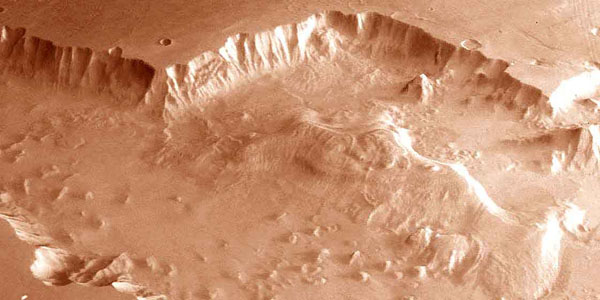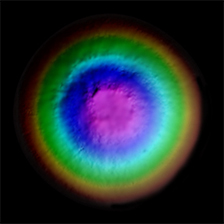Sub-glacially erupted volcanoes form free-standing flat-topped mesas, known as tuyas. Although there are some silicic edifices (e.g. Tuffen et al., 2002), most terrestrial sub-ice volcanoes are mafic and consist of horizontal layered basaltic lavas overlying friable flank deposits of steeply-dipping (angled) hyaloclastite breccias composed of variably-altered fine-grained palagonite material and basaltic clasts. When terrestrial volcanoes erupt underneath ice, they melt a vault and generate a meltwater lake within which a pillow mound and overlying tephra pile or tindar are constructed. Following emergence above the lake, lava-fed deltas are formed. If the volcano reaches the top of the meltwater lake or the vault is drained of water by a catastrophic flood event, then horizontally layered subaerial lava caprocks are deposited.
Many Martian mounds and ridges are compositionally and morphologically similar to many terrestrial basaltic tuyas and tindars. Like their terrestrial counterparts, the Martian features generally are associated with or lead to outflow channels. Some of the suggested Mars features, like the interior layered deposits in Valles Marineris, are much larger than terrestrial sub-ice volcanoes and approach the size of Hawaiian oceanic volcanoes (Chapman and Tanaka, 2001). Other Mars features, like ridges west of Elysium Mons (Chapman, 1994) and mesas near the poles (Garvin et al., 2000; Ghatan and Head, 2002; Ghatan et al., 2003) have sizes on the same scale as terrestrial sub-ice volcanoes.
Why do geologists study sub-ice volcanoes? On Earth, in habitated areas like Iceland, the catastrophic floods or jökulhlaups generated by these eruptions can be extremely hazardous. Study and monitoring of these volcanoes are intrinsic to civil warning systems. In remote areas like Antarctica, sub-ice eruptions can cause melting of the Antarctic Ice sheet, which on a large scale could potentially contribute to raising sea level and possibly have global climate effects. On Mars, there is active interest in the possibility of exobiologic life. Life generally requires water, so water-rich environments that are geothermally heated and nutrient rich, due to the presence of underground magma and local eruptions, would be ideal for biotic evolution. If the Martian features are sub-ice volcanoes perhaps these rocks house traces of extant life. In addition, the shapes and volumes of these Martian features can be used to indicate ancient ice thicknesses and possible outflow channel flood volumes.
There have been historic subglacial eruptions witnessed and studied by scientists, such as the recent Icelandic subglacial volcanic eruption at Grímsvötn eruption, 1996.


















